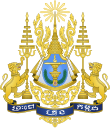Royal Cambodian Armed Forces
This article needs additional citations for verification. (June 2018) |
| Royal Cambodian Armed Forces | |
|---|---|
| កងយោធពលខេមរភូមិន្ទ | |
 Emblem of the Royal Cambodian Armed Forces | |
| Motto | ជាតិ សាសនា ព្រះមហាក្សត្រ ("Nation, Religion, King") |
| Founded | 9 November 1953 (original) |
| Current form | 24 September 1993 |
| Service branches | Royal Cambodian Navy |
| Headquarters | Ministry of National Defence, Georgi Dimitrov Blvd, Phnom Penh 12156 |
| Leadership | |
| Supreme Commander of the Armed Forces | King Norodom Sihamoni |
| Prime Minister | Hun Manet |
| Minister of National Defence | General Tea Seiha |
| Commander-in-Chief | General Vong Pisen |
| Chief of Joint Staffs | General Eth Sarath |
| Personnel | |
| Active personnel | 170,300 |
| Reserve personnel | 100,000 |
| Expenditure | |
| Budget | $770 million (2.5% GDP) (2023) |
| Industry | |
| Foreign suppliers | |
| Related articles | |
| History | Military history of Cambodia |
| Ranks | Military ranks of the Royal Cambodian Armed Forces |
The Royal Cambodian Armed Forces (RCAF; Khmer: កងយោធពលខេមរភូមិន្ទ, ខ.ភ.ម, UNGEGN: Kâng Yoŭthôpôl Khémôrôphumĭnt, K.P.M, ALA-LC: Kang Yodhabal Khemarabhūmind, K.B.M) is Cambodia's national military force. The Supreme Commander-in-Chief is King Norodom Sihamoni. Since 2018, General Vong Pisen has been the Commander-in-Chief of the RCAF as head of the Army, Navy, Air Force and the Gendarmerie.[1][2] The armed forces operate under the jurisdiction of the Ministry of National Defence. Under the country's constitution, the RCAF is charged with protecting the sovereignty and territorial integrity of the Kingdom of Cambodia.[3]
It was created in 1993 by a merger of the Cambodian People's Armed Forces (CPAF) and the National Army of Democratic Kampuchea (NADK) which included the Khmer Rouge, the Khmer People's National Liberation Front (KPNLF) and the National United Front for an Independent, Neutral, Peaceful and Cooperative Cambodia (Front uni national pour un Cambodge indépendant, neutre, pacifique, et coopératif, FUNCINPEC). The forerunner of the CPAF was the Kampuchean People's Revolutionary Armed Forces (KPRAF), established in 1979 with support from the People's Army of Vietnam (PAVN).[4]
History
[edit]Royal Khmer Armed Forces (FARK)
[edit]Khmer National Armed Forces (FANK)
[edit]Revolutionary Army of Kampuchea (RAK)
[edit]Kampuchean People's Revolutionary Armed Forces (KPRAF)
[edit]Cambodian People's Armed Forces (CPAF)
[edit]Royal Cambodian Armed Forces (RCAF)
[edit]The RCAF was established in 1993 after the democratic election of a government consisting of two prime ministers. The armed forces of all parties except the NADK were integrated into a national armed force.
To resolve security problems, the government began a "Win-Win policy" in mid-1995 of national reconciliation and unity efforts under the Monarchy of Cambodia. Defections of NADK units began in early 1996 up until the death of Pol Pot in 1998.
Branches
[edit]The RCAF has four branches: the Royal Cambodian Army, the Royal Cambodian Navy, the Royal Cambodian Air Force and the Royal Gendarmerie of Cambodia.
The Royal Cambodian Army (RCA) is the largest RCAF branch, with troops stationed in each of the country's 25 provinces. The Royal Cambodian Navy (RCN), the second-largest branch and operates in the Gulf of Thailand, along the Mekong and Bassac rivers and in the Tonlé Sap lake. The Royal Cambodian Air Force (RCAF), the smallest service branch with 5,000 members, operates in every province which has an airport.[5] The Royal Gendarmerie is the national gendarmerie force of the Kingdom of Cambodia. It is a branch of the RCAF and it is responsible for the maintenance of public order and internal security. It has a strength of 30,000 members deployed in all provinces.
See also
[edit]References
[edit]- ^ "New Commander-in-Chief for RCAF". KHMER TIMES. 22 March 2017. Retrieved 23 September 2018.
- ^ "Three top military commanders appointed as senior ministers". The Phnom Penh Post. 6 September 2018. Retrieved 23 September 2018.
- ^ "Hun Manet is now a four-star General". The Phnom Penh Post. 2 July 2018. Retrieved 23 September 2018.
- ^ "VGP News | National historical relic inaugurated in Đồng Nai – National historical relic inaugurated in Dong Nai". 2 January 2012.
- ^ Ian Ramage, Strong Fighting: Sexual Behavior and HIV/AIDS in the Cambodian Uniformed Services, 2002
Further reading
[edit]- Dylan Hendrickson, 'Cambodia's security-sector reforms: limits of a downsizing strategy,' Conflict, Security, and Development, Volume 1, Issue 1.
- Gerald Segal and Mats Berdal, 'The Cambodia Dilemma,' Jane's Intelligence Review, March 1993, p. 131-2. Includes listing of formations and equipment of the various factions.
- Robert Karniol, 'Confined to local waters,' Naval Forces Update, Jane's Defence Weekly, 20 June 1992, p. 1097. Status of Cambodian navy.


